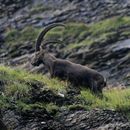en
names in breadcrumbs


In the eighteenth century some Europeans believed ibex were magical. Today's equivalent of the magical ibex is the zodiac sign Capricorn.
Perception Channels: tactile ; chemical
Alpine ibex have sustainable populations due to successful reintroduction programs.
US Federal List: no special status
CITES: no special status
IUCN Red List of Threatened Species: least concern
Ibex may compete with domestic goats (Capra hircus) for food and water.
In addition to trophy hunting, there was a market for the parts of ibex believed useful in medicinal purposes.
Positive Impacts: food ; body parts are source of valuable material; source of medicine or drug
As a browser, this ibex probably influences the vegetational community, As a prey species, it is likely that the availablitliy of ibex affects the populations of predators.
In the spring the animals migrate back into the mountains to new feeding areas. In the winter when the snow is deep and the weather is severe they migrate down to south facing slopes which have more food and less snow. These browsers and grazers become active in the afternoon and into the evening and feed through out the night in the forest, returning to the rock cliffs in the morning.
Foods commonly eaten include: grasses, forbs, leaves, shoots and bark.
Plant Foods: leaves; wood, bark, or stems
Primary Diet: herbivore (Folivore , Lignivore)
Alpine ibex, Capra ibex, are found in central Europe south to northern Ethiopia and east to Central China.
Biogeographic Regions: palearctic (Native ); ethiopian (Native )
Alpine ibex are mountain animals usually living at elevations up to 3,200 meters. Males stay up on the rock cliffs during the day, whereas females stay below in the rolling slopes and brushy areas. At night they will all move down into the forest for the night to feed.
Range elevation: 3200 (high) m.
Habitat Regions: temperate ; terrestrial
Terrestrial Biomes: chaparral ; forest ; scrub forest ; mountains
The lifespan of an alpine ibex in the wild is about 10 – 18 years. In captivity the oldest know individual was 21 years and 3 months.
Range lifespan
Status: captivity: 21.25 (high) years.
Typical lifespan
Status: wild: 10 to 18 years.
Average lifespan
Status: captivity: 22.3 years.
Alpine ibex are sexually dimorphic. Males range from 65 – 105 cm in height at the shoulder and weigh about 80 - 100 kg. Shoulder heights in females are about 65 – 70 cm and weight varies from 30 – 50 kg. The length of an ibex is about 1.3 – 1.4 m long with a tail length about 120 – 150 cm. Their coats are uniformly brown to gray, with thick beards. The underside of southern alpine ibex is lighter than the northern alpine ibex. Nubian (Capra nubiana) and Walia ibex (Capra walie) are smaller than alpine ibex.
Range mass: 65 to 100 kg.
Range length: 1.3 to 1.4 m.
Other Physical Features: endothermic ; homoiothermic; bilateral symmetry
Sexual Dimorphism: male larger; ornamentation
Ibex are herding animals which are subject to a wide variety predators. Eagles, bears, leopards and humans all play significant roles in regulating the ibex population.
Known Predators:
The mating system is polygynous. Males compete in fighting competition to mate with a group of females.
Mating System: polygynous
Males join the females in December after fierce battles with other males. The winner of the battle obtains the right to breed with group of 10 – 20 females. The gestation period for the ibex is approximately 147 – 180 days. A day after parturition, the young are able to walk on the rock cliffs following their mothers. The young are mature at 8 – 12 months, but don’t breed until 2 or 3 years of age. Ibex typically have one young per year, and more than one is uncommon.
Breeding interval: Alpine ibex breed once yearly.
Breeding season: Mating occurs in late fall.
Range number of offspring: 1 to 2.
Average number of offspring: 1.11.
Range gestation period: 4.9 to 6 months.
Range weaning age: 3 to 12 months.
Range age at sexual or reproductive maturity (female): 10 (low) months.
Range age at sexual or reproductive maturity (male): 10 (low) months.
Key Reproductive Features: iteroparous ; seasonal breeding ; gonochoric/gonochoristic/dioecious (sexes separate); sexual ; viviparous
Average birth mass: 2850 g.
Average number of offspring: 1.1.
Females provide milk for their young, as do all mammalian females. The young are precocious, and are able to follow their mothers shortly after birth.
Parental Investment: altricial ; pre-fertilization (Provisioning, Protecting: Female); pre-hatching/birth (Provisioning: Female, Protecting: Female); pre-weaning/fledging (Provisioning: Female, Protecting: Female); post-independence association with parents